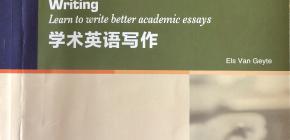Weeks 3-4: Reader expectation and essay structure;
Essay content and language
Leading-in:
Assignment check and review of Chapter 1
Chapter 2 Reader Expectation and Essay Structure
Aims:
ü plan your essay structure
ü guide your reader through structure, signposting and cohesion
ü understand paragraph structure and how to connect paragraphs
Part One: Self-evaluation
Let Ss read the list of statements and circle the answer according to their condition.
1. I know how to write an outline for an essay based on an analysis of the essay title.
2. I know what I am normally expected to include in the introduction to an essay.
3. I always write my introduction first.
4. I know what to include in the conclusion of an essay.
5. I know how to use signposting and cohesion to guide the reader through my essay.
6. I know what the parts of paragraph usually are.
Part Two:On Writing and Discussing in Group
On Question Discussion
What is the reader expectation?
On Writing
1. Making your essay more readable
ü The content of your essay is the core.
ü Easy to read in a number of ways.
2. Essay structure
ü The basic structure for short essay and long essay.
ü The three-part structure applicable to any essay.
ü The methods often be employed in essay writing.
2.1. The introduction
a) Give a description or explanation of the situation or problem (more general).
b) Say why this situation or problem (or a more specific aspect of it) is important
c) Say what your aim is, what your position on the situation or problem is, and what the organization of your essay will be.
d) The length of introduction is likely to contain no more than 10 per cent of the word count.
2.2 The conclusion
a) A summary of the main ideas (related to the importance to the topic).
b) A summary of your evidence (with your evaluation of it).
c) Your overall conclusion/ your answer to the question.
d) The conclusion will be more specific than the introduction.
e) Do not add any new evidence or ideas.
f) The conclusion is likely to contain no more than 10 per cent of the word count.
2.3 The main body
The main body of the text consists of a number of paragraphs, blocks of text tat develop ideas. See more details in The Structure of Paragraphs.
3. Guiding your reader
ü The importance of guiding your reader.
ü To tell them about the structure (signposting)
ü To use language that show that the different aspects of your writing relate to each other (cohesion)
ü To distinguish clearly between paragraphs(paragraphing)
4. The structure of paragraphs
A paragraph normally has three parts:
ü A sentence that introduces the topic (and possibly links it to the previous paragraph).
ü A number of sentences that develop the topic (with analysis, evidence, or detail).
ü A sentence that concludes the topic (or links it to the next topic/ paragraph).
5. Connecting paragraphs
ü To show the relationship between two continuous paragraphs by using different ways.
ü See more examples in this part.
Part Three: Peer-review and Feedback
Work in group of 3 or 4 students, review each other’s writing task, and give feedback accordingly.
ü Essay structure--- introduction/body/conclusion/
ü Planning--- do an initial outline based on an analysis of the essay question.
ü Introduction --- includes an explanation of the situation and its importance, as well as a statement of the aim of the essay and an indication of its structure.
ü Conclusion --- includes a summary of the main ideas, a review and evaluation of the evidence, and an answer to the question.
ü Paragraphs have a tree-part structure with their own introductory and concluding sentence(s), and analysis, evidence or detail in between; they often refer forward and backwards to other paragraphs.
ü Readability becomes very important in long essays.
ü Linking words need to be used in longer text.
Part Four: Assignment
1. Glossary: outline, principle, cohesion, distinguish, guild, indent, obstacle, argument, measure, policy
2. Finish Exercise 5
